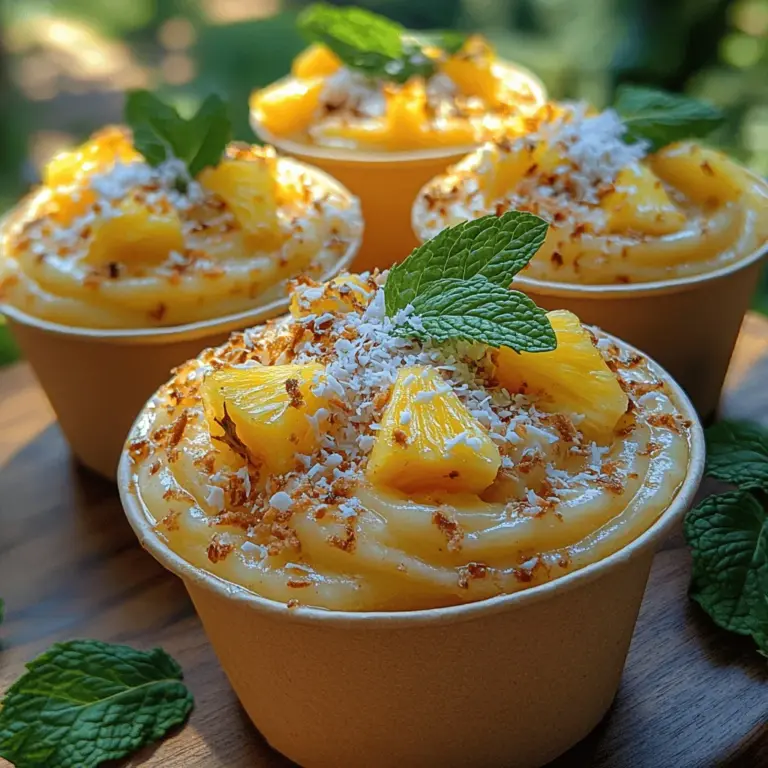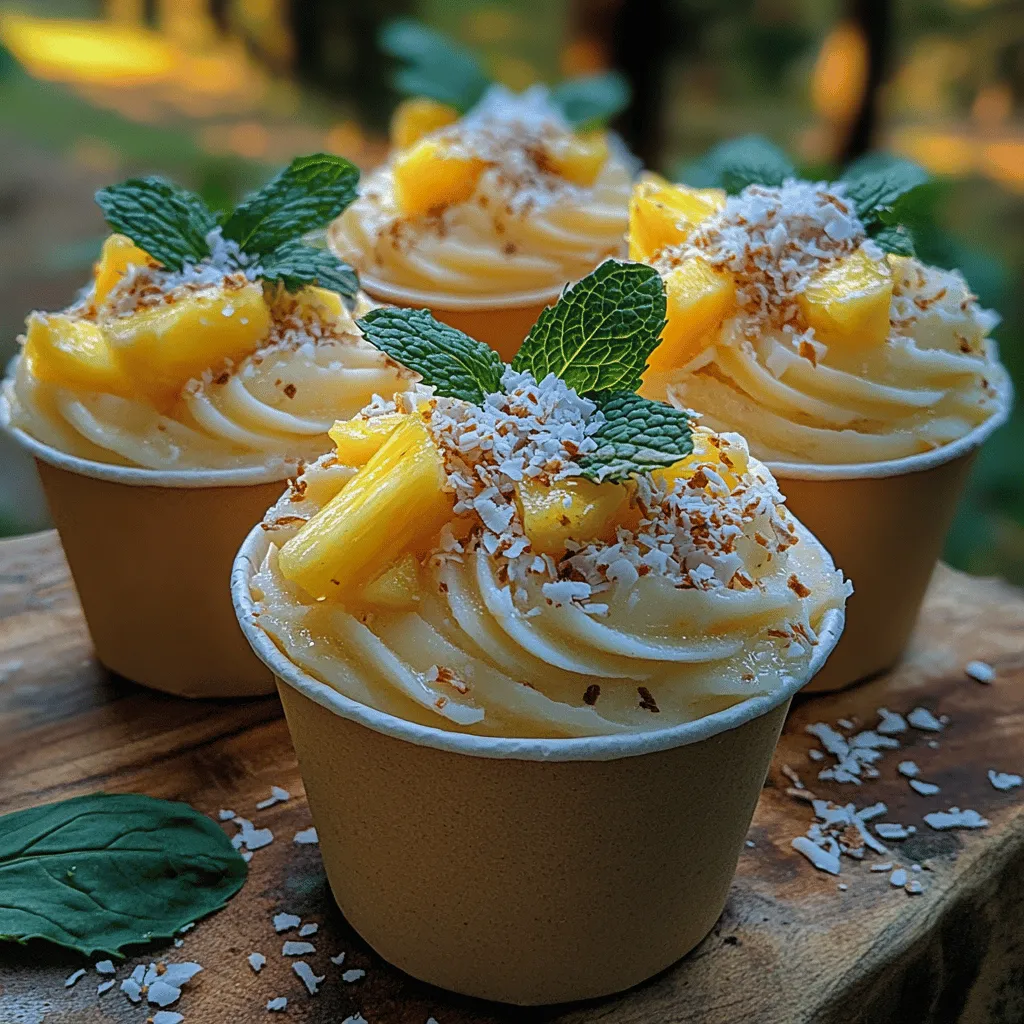Introduction
If you’re looking to bring a taste of the tropics to your kitchen, look no further than Tropical Frozen Pineapple Coconut Cups. This delightful recipe combines the juicy sweetness of fresh pineapple with the creamy richness of coconut milk, creating a refreshing treat that is perfect for warm days, summer gatherings, or simply as a healthy dessert option. The vibrant flavors not only evoke images of sun-soaked beaches but also offer a sensory escape that is sure to uplift your spirits.
One of the best aspects of this recipe is its simplicity. With just a few fresh ingredients and minimal preparation, you can create a visually stunning dish that is both delicious and nutritious. Pineapple is packed with vitamins, minerals, and antioxidants, while coconut milk adds a creamy texture that elevates the overall experience. Together, these ingredients create a harmonious blend of flavors that are not only satisfying but also beneficial for your health.
Whether you’re hosting a summer barbecue, enjoying a cozy evening at home, or looking for a fun treat to share with friends, these frozen pineapple coconut cups are an ideal choice. They are easy to make, require no baking, and can be customized to suit your taste preferences. Let’s dive into the specifics of what you’ll need to create these tropical delights and how to prepare them flawlessly.
Understanding the Ingredients
Fresh Pineapple
Fresh pineapple is the star of this recipe, bringing a natural sweetness and vibrant color that makes these cups so appealing. Not only does pineapple taste incredible, it’s also loaded with nutrients. This tropical fruit is rich in vitamin C, which supports the immune system, and manganese, which plays a role in bone formation and metabolism. Additionally, pineapple contains bromelain, an enzyme known for its anti-inflammatory properties and ability to aid digestion.
When selecting a fresh pineapple, look for one that is firm but slightly soft when pressed. The color should be a golden yellow, indicating ripeness, and you should be able to smell its sweet aroma near the base. Avoid pineapples with soft spots or brown patches, as these can indicate overripeness or spoilage.
To prepare fresh pineapple for this recipe, start by cutting off the top and bottom, which will create a stable base. Stand the pineapple upright on a cutting board, and carefully slice off the skin, following the contours of the fruit. After peeling, cut the pineapple in half lengthwise. Remove the tough core with a knife, and dice the fruit into small, bite-sized pieces, reserving a few pieces for garnish.
Coconut Milk
Coconut milk is another essential ingredient in this recipe, contributing a creamy texture and rich flavor that balances the sweetness of the pineapple. For the best results, opt for full-fat coconut milk, as it provides a luxurious creaminess that enhances the overall mouthfeel of the dish. Full-fat coconut milk is also a good source of healthy fats, particularly medium-chain triglycerides (MCTs), which can provide a quick source of energy and may support weight management.
If you’re looking for alternatives due to dietary needs or preferences, there are several options available. Light coconut milk can be used for a lower-calorie version, but keep in mind that it may not achieve the same creamy consistency. For those avoiding coconut altogether, alternatives like almond milk or cashew cream can work, though they will alter the flavor profile.
Sweeteners: Honey vs. Maple Syrup
To enhance the natural sweetness of the pineapple, you may want to add a sweetener. Honey and maple syrup are both excellent choices, each offering their own unique flavor profiles. Honey has a floral sweetness and is often considered a healthier option due to its antioxidants and potential antibacterial properties. However, it’s important to note that honey is not suitable for vegans.
On the other hand, maple syrup provides a distinct, earthy flavor and is completely plant-based, making it a great option for vegan diets. When adjusting sweetness in your recipe, start with a small amount and taste as you go. Everyone’s preference for sweetness varies, so you can easily modify the amount of sweetener to suit your taste.
Shredded Coconut
In addition to fresh pineapple and coconut milk, incorporating shredded coconut into your cups adds texture and an extra boost of coconut flavor. You can find various types of shredded coconut, including sweetened and unsweetened varieties, as well as different textures ranging from fine to flaked. For this recipe, unsweetened shredded coconut is recommended, as it complements the natural sweetness of the pineapple without overpowering it.
Coconut is a nutritional powerhouse, packed with fiber, vitamins, and minerals. It may also support heart health by improving cholesterol levels and providing healthy fats. Including shredded coconut in your diet can be a delicious way to reap these benefits.
Optional Garnishes
To elevate the presentation of your Tropical Frozen Pineapple Coconut Cups, consider adding garnishes. Fresh mint leaves not only enhance the aesthetic appeal but also add a refreshing flavor that pairs beautifully with the tropical ingredients. Simply pluck a few mint leaves and place them atop each cup for a pop of color and a hint of herbal brightness.
For additional garnishing ideas, consider using a sprinkle of extra shredded coconut, a drizzle of honey or maple syrup, or even a few slices of fresh fruit, such as kiwi or strawberries, for added color and flavor contrast. The garnishes are optional but can make your dish look even more enticing.
Step-by-Step Instructions
Preparing the Pineapple
Now that you have an understanding of the ingredients, it’s time to get started on the preparation. The first step involves properly preparing the fresh pineapple, which will serve as the delightful cup for our frozen treat.
1. Peeling the Pineapple: Begin by rinsing the pineapple under cold water to remove any dirt or contaminants. Place it on a clean cutting board. With a sharp knife, slice off the top and bottom of the pineapple, creating a stable base.
2. Removing the Skin: Stand the pineapple upright and carefully cut away the skin in downward strokes, following the natural curve of the fruit. Ensure you remove all the “eyes” (the small brown spots) to avoid bitterness.
3. Coring the Pineapple: Once the pineapple is peeled, slice it in half lengthwise. Using a paring knife, carefully cut out the tough core from each half. Discard the core, as it is not edible.
4. Dicing the Pineapple: With the pineapple halves now free of skin and core, cut them into smaller sections. Dice the fruit into bite-sized pieces that will easily blend with the coconut milk.
5. Reserving Pineapple for Garnish: As you prepare the diced pineapple, set aside a few pieces for garnish later. These can be small cubes or decorative slices, depending on how you wish to present your cups.
By following these steps, you’ll have perfectly prepared pineapple ready to transform into refreshing frozen cups. The next phase will involve blending the pineapple with coconut milk and sweeteners to create a smooth, tropical mixture. Stay tuned as we explore the next steps in creating your Tropical Frozen Pineapple Coconut Cups!
Blending the Mixture
To achieve the perfect Tropical Frozen Pineapple Coconut Cups, the blending process is crucial. Start by adding your frozen pineapple chunks, coconut cream, and any other liquid ingredients into a blender. It’s best to use a high-speed blender for this task, as it will help create an ultra-smooth consistency. Begin blending on a low speed to break down the frozen fruit, then gradually increase the speed until you reach a creamy texture.
Techniques for Achieving a Smooth Consistency
For the smoothest results, consider these blending techniques:
1. Thaw Slightly: If your pineapple chunks are rock solid, let them sit at room temperature for about five minutes before blending. This will make it easier for the blender to process them without overworking the motor.
2. Pulse Feature: Use the pulse feature on your blender intermittently. This allows for a more controlled blend, ensuring no large chunks remain while preventing the mixture from overheating.
3. Scrape Down the Sides: Occasionally stop the blender to scrape down the sides with a spatula. This ensures that all ingredients are evenly incorporated and blended well.
Importance of Blending Thoroughly for Texture
Blending thoroughly is key to creating a smooth texture that resembles ice cream. A well-blended mixture will ensure that each bite of your Tropical Frozen Pineapple Coconut Cups is creamy and delightful. Inadequately blended mixtures can lead to a chunky texture, which detracts from the overall eating experience. Aim for a velvety finish that seamlessly combines the tropical flavors of pineapple and coconut.
Incorporating Shredded Coconut
Once your mixture is smooth, it’s time to incorporate shredded coconut. This step adds a delightful chewy texture and enhances the tropical flavor profile of your cups.
Method of Mixing by Hand and Why It Matters
Instead of blending the shredded coconut into the mixture, gently fold it in by hand. This method is important because it preserves the delicate texture of the coconut, adding a pleasant bite to the creamy base. Use a spatula to lift and fold the mixture, ensuring that the coconut is evenly distributed without overmixing. This technique allows the coconut to maintain its shape and provides a lovely contrast against the smoothness of the pineapple-coconut base.
Portioning into Cups
Now that your mixture is ready, it’s time to portion it into cups. Choosing the right cups is essential for both aesthetics and functionality.
Choosing the Right Cups: Paper vs. Silicone
Paper cups are a popular choice for their convenience and easy disposal, but silicone cups offer advantages that are worth considering. Silicone cups are reusable, flexible, and allow for easy removal of the frozen treats without sticking. They also provide a fun, colorful presentation. Whichever option you choose, make sure the cups are sturdy enough to hold the mixture without leaking.
Tips for Ensuring Proper Filling and Freezing
When filling your cups, leave a little space at the top to allow for expansion as the mixture freezes. Use a measuring cup or a funnel to help pour the mixture evenly into each cup. Once filled, tap the cups gently on the countertop to eliminate air bubbles and ensure even distribution.
Freezing Process
The freezing process is where the magic happens. To achieve the best texture and flavor, follow these best practices.
Best Practices for Freezing to Ensure Optimal Texture
After filling your cups, place them in the freezer on a flat surface to ensure they freeze evenly. Avoid stacking the cups, as this can lead to uneven freezing and texture issues. It’s essential to cover the cups loosely with plastic wrap, which prevents ice crystals from forming on the surface while allowing moisture to escape.
Recommended Freezing Time for Best Results
For optimal results, freeze the Tropical Frozen Pineapple Coconut Cups for at least 4-6 hours, or until completely solid. If you can wait overnight, that’s even better! This ensures that the flavors meld together beautifully, and the cups achieve a creamy, ice-cream-like consistency.
Serving Suggestions
Once your Tropical Frozen Pineapple Coconut Cups are fully frozen, it’s time to serve them. Here’s how to do it effectively.
Instructions for Thawing and Serving
To serve, remove the cups from the freezer and let them sit at room temperature for about 5-10 minutes. This will make it easier to scoop out the frozen mixture. If you’re using silicone cups, gently pull the sides to release the frozen treat. For paper cups, running warm water around the outside can help loosen the sides.
Creative Serving Ideas to Enhance Presentation
For an added touch, consider garnishing your Tropical Frozen Pineapple Coconut Cups with fresh fruit slices, a sprinkle of toasted coconut, or a drizzle of honey or agave syrup. You can also serve them alongside a tropical fruit salad or a scoop of dairy-free yogurt for a refreshing contrast.
Health Benefits of Tropical Frozen Pineapple Coconut Cups
These delightful cups are not only delicious but also packed with health benefits.
Nutritional Highlights of the Main Ingredients
Pineapple is rich in vitamins C and B6, manganese, and dietary fiber, promoting digestion and boosting the immune system. Coconut cream adds healthy fats that can provide a quick source of energy, while shredded coconut is high in dietary fiber, aiding in gut health.
Benefits of Enjoying Frozen Desserts Over Traditional Options
Frozen desserts like these Tropical Frozen Pineapple Coconut Cups are a healthier alternative to traditional ice cream, often loaded with added sugars and artificial ingredients. These cups are naturally sweetened by the fruit, making them a guilt-free indulgence that satisfies your sweet tooth while keeping you nourished.
How This Recipe Can Fit Into Various Dietary Lifestyles
This recipe is incredibly versatile, making it suitable for various dietary lifestyles. It’s vegan, gluten-free, and can be made without refined sugars, catering to those with dietary restrictions. By using alternative sweeteners or plant-based milks, you can easily customize this recipe to fit your needs.
Creative Variations and Additions
While the classic Tropical Frozen Pineapple Coconut Cups are fantastic as is, there are many ways to customize the recipe to suit your taste preferences.
Suggestions for Flavor Enhancements
Consider adding a splash of lime juice or zest to brighten the flavors and provide a zesty kick. Grated fresh ginger can also add an aromatic warmth that complements the tropical notes beautifully.
Ideas for Adding Other Fruits or Nuts
Feel free to experiment with other fruits! Mangos, bananas, or berries can be blended in for a delicious twist. You can also add chopped nuts like macadamias or almonds for a crunchy contrast.
Exploring Different Types of Milk or Sweeteners for Unique Twists
If you’re looking for a creamier texture, try substituting coconut milk for the coconut cream. For sweetness, explore alternatives such as maple syrup, agave nectar, or dates to create a unique flavor profile that suits your palate.
Conclusion
Making and enjoying Tropical Frozen Pineapple Coconut Cups is not just about savoring a delicious dessert; it’s about the joy of creating something refreshing and wholesome. With its delightful tropical flavors, this recipe invites you to experiment with different variations and find your perfect blend.
Encourage yourself to embrace the creativity of homemade desserts. Whether you share them with friends at a summer gathering or indulge in a quiet moment of bliss, these cups are a delightful treat any time of the year. So gather your ingredients, blend, freeze, and enjoy a taste of the tropics right at home.



